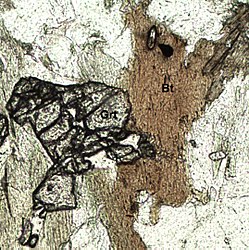Magnitude
Minerals that stand out significantly (have a difference in refractive index of .12 or more) have high or strong relief, and will have very sharp boundaries between itself and the material it is next to. Intermediate is .04 to .12, and low or weak is less than .04. Low relief materials have boundaries that are hard to distinguish from each other.
- Thin section under plane-polarized light with the high relief mineral clinopyroxene in the center surrounded by the low relief mineral plagioclase feldspar.

